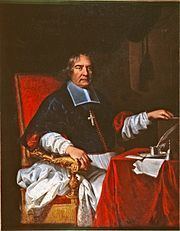 | ||
Hyacinthe Serroni (August 30, 1617, Rome – January 7, 1687 Paris) was an Italian catholic priest, Bishop, diplomat and steward of the Navy for the kingdom of France.
Contents
Career
Sent by Pope Urban VIII, he arrived in France in 1645, where he earned a doctor of theology. From 1646 he became bishop of Orange, but latter returned to Rome. He returned to France in 1648 and became apostolic vicar of the ecclesiastical province of Tarragona. After five years in the service of the bishop, the King appointed him superintendent of the navy and the province of Provence, and latter Catalonia until the truce between France and Spain. In 1660, he was appointed with Pierre de Marca, Archbishop of Toulouse, to participate in the Conference of Ceret which was to set the boundaries between France and Spain, but which separated without concluding. On 12 November 1660 he signed the Treaty of Llívia as representative of Louis XIV, which are discussed in detail the thirty-three villages of Cerdagne who had to belong to France under the Treaty of the Pyrenees.
In 1661 he was appointed bishop of Mende by the King. So he left Orange. Then, in 1676, he obtained the bishopric of Albi. In 1676, the diocese was erected by Archbishop Hyacinthe and Serroni is the first archbishop of Albi, until his death in 1687. From 1679 he convened a synod which gathers all the clergy of his diocese. Synodal Orders are published the same year. To ensure the "holy reformation" and the quality of its clergy, Serroni installs a seminar in 1679 in a house of Bout-du-Pont in Albi. The management is entrusted to the Jesuits.
His writings
Meditations and affections on the seven psalms of penance for the use of the new converts, 1686 Interviews emotional soul with God over one hundred and fifty psalms, 1688.
Representation in Art
The new archbishop of Albi was painted in 1685 by Hyacinthe Rigaud, recently arrived in Paris, against 330 pounds ( "the Archbishop of Alby (Hyacinthe Seronis)".
The table for passing the original is now in the Toulouse-Lautrec Museum in Albi, and has been engraved by the German Frans Ertinger (Schwaben, 1640 - Paris, 1710) (Inv. 149), according to Henri in 1688 van Hulst, the first biographer of Rigaud: "Figure knees. The first portrait of this magnitude has ever been Mr. Rigaud, then twenty years only, he told himself. The print medium shape. "
The bust was echoed by Pierre Simon, for a thesis by Louis Boistel
